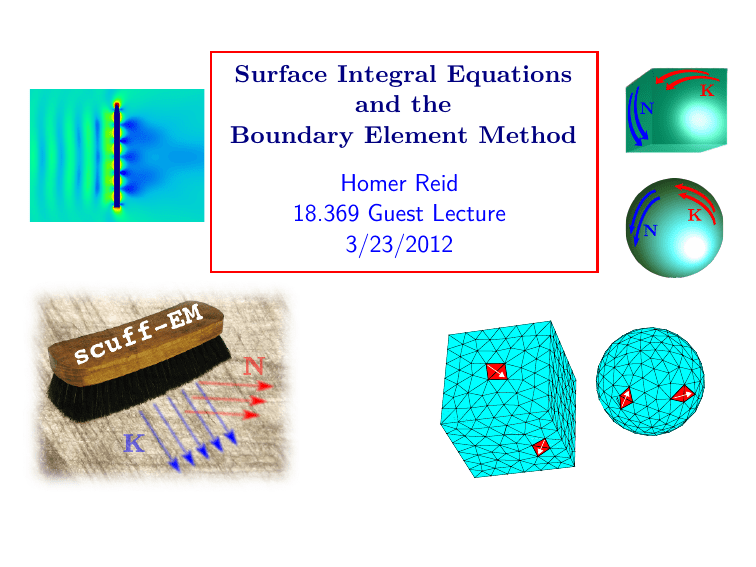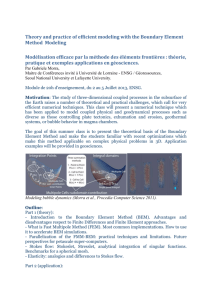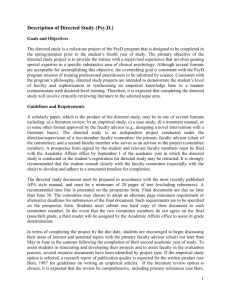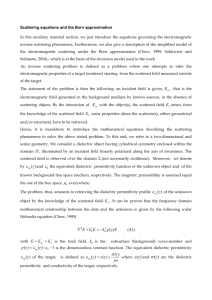Surface Integral Equations and the Boundary Element Method Homer Reid
advertisement

Surface Integral Equations
and the
Boundary Element Method
Homer Reid
18.369 Guest Lecture
3/23/2012
Electromagnetic Scattering Problems
We have some known incident field (such as a plane wave), scattering from
some known geometry (including objects of known shapes and materials)
and we want to know the scattered fields. (Note: all quantities ∼ e−iωt .)
known
known
Homer Reid: SIE/BEM Approach to Computational Electromagnetism
unknown
3/23/2012
2 / 16
Methods for Solving EM Scattering Problems, 1
Expansions in special functions
Write the fields inside and outside the scatterer as expansions in sets of known Maxwell solutions
(in some convenient coordinate system) and match coefficients.
Advantages:
• Exploits known Maxwell solutions
=⇒ efficient
Disadvantages:
• Only works for a small number of geometries
=⇒ not general.
One Sphere: “Mie scattering”
f (x) ∼ jl (r)Ylm (θ, φ)
Planar Slab: “Fresnel Coefficients”
f (x) ∼ eik·x
Homer Reid: SIE/BEM Approach to Computational Electromagnetism
3/23/2012
3 / 16
Methods for Solving EM Scattering Problems, 2
Finite-Difference Method
• Discretize the geometry onto a grid (each grid point can have different , µ)
• Write Maxwell’s equations using finite-difference approximations to derivatives
• Solve sparse linear system for the E-field values at grid points
h
i
2
∇×∇× − k E = −iωJ =⇒
M
E1
J1
.
..
=
iω
.
.
.
En
Jn
Advantages:
• Allows different , µ at each grid point
−→ general
• Relatively easy to implement
Disadvantages:
• Does not make use of known Maxwell solutions
−→ not the most efficient method
• If we need to evaluate the scattered fields far from
the scattering objects, we have to discretize the
entire space between the objects and the evaluation
point. −→ Seems wasteful.
Homer Reid: SIE/BEM Approach to Computational Electromagnetism
3/23/2012
4 / 16
Methods for Solving EM Scattering Problems, 3
Surface-Integral-Equation (SIE) Method
• First compute the surface current distribution K(x) induced by the incident field
• Then compute the scattered fields using K(x) and known Maxwell solutions:
E
scat
I
0
0
G(x − x )K(x )dx
(x) =
0
where G is the solution to
h
i
2
∇ × ∇ × − k G(r) = −iω1δ(r);
S
G (the “dyadic Green’s function”) is known in closed form
Advantages:
• Exploits known Maxwell solutions =⇒ efficient
• Allows scatterers of arbitrary shapes and arbitrary
(homogeneous) materials =⇒ general
• Unknown quantities confined to object surfaces,
not everywhere in space =⇒ not wasteful
Disadvantages:
• Difficult to implement
• Restricted to homogeneous scatterers, i.e.
piecewise-constant , µ
Homer Reid: SIE/BEM Approach to Computational Electromagnetism
3/23/2012
5 / 16
SIE Formulation of Scattering Problems
Consider a perfectly electrically conducting (PEC) scatterer in vacuum.
The incident field induces a surface electric current density K(x) on the object surface.
Surface current density K: units of
current
length
J(xk , z) =
| {z }
volume current
K(xk ) · δ(z)
| {z }
surface current
Once we know K(x), we can compute the scattered E−field anywhere we like:
I
Escat (x) =
G(x − x0 )K(x0 )dx0
S
eikr
Gij (r) =
4πk2 r3
h
i
h
1 − ikr + (ikr)3 δij + − 3 + 3ikr − (ikr)2
ir r i j
r2
r = |r|,
k=
ω
c
We determine K(x) by requiring that the total tangential E-field vanish at the object surface:
h
i
Einc (x) + Escat (x) = 0
k
(for points x on object surfaces)
I
=⇒
S
Gk (x, x0 )K(x0 )dx0 = −Einc
k (x)
“electric field integral equation” (EFIE)
The EFIE is an integral equation for K(x) in terms of Einc .
Homer Reid: SIE/BEM Approach to Computational Electromagnetism
3/23/2012
6 / 16
Numerical Solution of SIEs
The boundary element method (BEM)
Given Einc (x), want to find K(x) that solves the EFIE:
I
S
Gk (x, x0 )K(x0 )dx0 = −Einc
k (x)
Idea: (1) expand K(x) in some convenient set of N basis functions =⇒ N unknown coefficients
N
X
K(x) =
n
o tangential vector-valued basis functions
fn (x) =
defined on the object surface
kn fn (x),
n=1
Idea: (2) test (inner-product) the EFIE with each basis function =⇒ N equations
*
+
I
fm ,
G · K dA
|{z}
P
*
= − fm , Einc
+
=⇒
kn fn
M
k v
1
1
. .
.. = ..
kN
vN
N × N linear system (“BEM system”)
D E
Matrix elements: Mmn = fm Gfn
D E
RHS vector: vm = − fm Einc
Homer Reid: SIE/BEM Approach to Computational Electromagnetism
3/23/2012
7 / 16
Basis functions for SIE/BEM solvers
One choice for compact 3D objects: “RWG basis functions”
Begin by discretizing (“meshing”) object surfaces into triangles:
Associate one basis function with each internal edge:
• These are “RWG basis functions” (named for
their inventors: Rao, Wilton, Glisson)
• # of basis functions N ∝ # of triangles
• As we refine the discretization (shrink the
triangles), the discretization errors decrease,
but the cost of solving the linear system grows
like N 3
Homer Reid: SIE/BEM Approach to Computational Electromagnetism
3/23/2012
8 / 16
Steps in a BEM Scattering Calculation
For a compact 3D scattering problem using RWG basis functions
1. Discretize object surfaces into triangles.
• A well-studied problem; high-quality free software packages are available.
2. Analyze the surface mesh and assign one basis function fn (x) to each interior edge.
• Some minor computational work; not too challenging.
3. Most difficult step: Assemble the BEM matrix M and RHS vector v.
D E
vm = − fm Einc
D E
Mmn = fm Gfn ,
4. Solve the linear system Mk = v for the surface-current expansion coefficients {kn }.
• For N . 10, 000, use standard linear algebra software (lapack).
P
kn fn (x) to compute the scattered fields.
5. Use the surface current density K(x) =
Escat (x) =
X
Z
kn
GEE (x, x0 )fn (x0 )dx0 ,
Hscat (x) =
n
X
Z
kn
GME (x, x0 )fn (x0 )dx0 ,
n
where GEE is what we called “G” before and GME ∼ ∇ × GEE .
Homer Reid: SIE/BEM Approach to Computational Electromagnetism
3/23/2012
9 / 16
Why is it so hard to assemble the BEM matrix?
Consider a scattering geometry with surfaces discretized into N ∼ 10, 000 triangles.
1. We have N 2 =100 million matrix elements.
2. Each matrix element involves a 4 dimensional integral (surface integrals over two
triangles) that must be evaluated numerically.
3. A sizeable fraction of these are singular integrals.
Homer Reid: SIE/BEM Approach to Computational Electromagnetism
3/23/2012
10 / 16
SIE/BEM Techniques for Non-PEC Geometries
For non-PEC geometries we must introduce effective magnetic surface currents
For PEC scatterers, the SIE/BEM procedure reflects a physical reality: the currents induced by
the incident field are confined to the object surface.
For general (non-PEC) scatterers, this is no longer true: the incident field induces currents
throughout the volume of the scatterer.
Two
options:
1. Volume integral equation: Write an integral equation for the volume electric
current distribution J(x) throughout the bulk of the scatterer.
2. Surface integral equation: Write an integral equation for effective electric and
magnetic surface currents K(x), N(x) on the surface of the scatterer.
PEC
Non-PEC
Physics
Surface electric current K
Volume electric current J
Mathematics
Surface electric current K
Surface electric and magnetic currents K, N
Homer Reid: SIE/BEM Approach to Computational Electromagnetism
3/23/2012
12 / 16
Effective Surface Currents for non-PEC Geometries
The Stratton-Chu equations
Recall Green’s theorem: For a scalar field φ satisfying Laplace, knowledge of φ (or ∂∂φ
) on the
n̂
boundary ∂Ω of a closed source-free region Ω suffices to recover φ everywhere in the interior.
I
G(x, x0 )φ(x0 )dA
φ(x) =
∂Ω
The Stratton-Chu equations generalize Green’s theorem to the case of vector fields satifying
Maxwell: knowledge of tangential E, H on ∂Ω suffices to recover E and H throughout Ω.
h
i
h
i
GEE (x, x0 ) n̂ × H(x0 ) + GEM (x, x0 ) − n̂ × E(x0 ) dA
∂Ω
I h
i
h
i
H(x) =
GME (x, x0 ) n̂ × H(x0 ) + GMM (x, x0 ) − n̂ × E(x0 ) dA
I
E(x) =
∂Ω
The source quantities that enter the Stratton-Chu equations are n̂ × H and −n̂ × E. Think of
these as effective surface currents:
Keff (x) ≡ n̂ × H,
Neff (x) ≡ −n̂ × E.
Homer Reid: SIE/BEM Approach to Computational Electromagnetism
3/23/2012
13 / 16
BEM Formulation for non-PEC Scatterers
Generalizing the EFIE
Fields inside and outside the scatterer:
I Ein (x)
K(x0 )
=−
Gin (x, x0 )
dx0
0
in
N(x )
H (x)
∂Ω
Eout (x)
Hout (x)
I
=+
Gout (x, x0 )
∂Ω
K(x0 )
N(x0 )
dx0 +
Einc (x)
Hinc (x)
Match tangential fields at the scatterer surface (for points x ∈ ∂Ω):
Ein
(x)
k
= Eout
(x)
k
Hin
(x)
k
= Hout
(x)
k
I
=⇒
K(x0 )
Einc (x)
0
Gout + Gin
dx
=
−
N(x0 )
Hinc (x) k
∂Ω
k
Integral equation for K, N in terms of Einc , Hinc
Discretize by expanding K(x) =
!
M
kn
nn
P
kn fn (x),
!
=
E
vn
N (x) =
P
nn fn (x):
!
H
vn
(”PMCHW Formulation”)
=⇒ 2N × 2N linear system for the expansion coefficients {kn , nn }
Homer Reid: SIE/BEM Approach to Computational Electromagnetism
3/23/2012
14 / 16
scuff-em: An open-source BEM code suite
Surface-Current / Field Formulation of ElectroMagnetism
http://homerreid.com/scuff-EM
Features currently available:
•
•
•
•
•
Scattering from compact 3D objects of arbitrary shapes
Arbitrary user-specified frequency-dependent , µ (isotropic, linear, piecewise constant)
Linux/Athena command-line interface to scattering code
C++ interface to scattering code
Application modules: Casimir forces, RF device modeling
Features coming soon:
• Python / Matlab interfaces to scattering codes
• Scattering from periodic geometries
Homer Reid: SIE/BEM Approach to Computational Electromagnetism
3/23/2012
15 / 16
Solving scattering problems with scuff-em
Scattering of a gaussian laser beam from a silver nanotip
scuff-scatter --geometry Tip.scuffgeo
--Omega 2.3
--pwDirection 0 0 1
--pwPolarization 1 0 0
--EPFile MyEvalPoints
Tip mesh:
Homer Reid: SIE/BEM Approach to Computational Electromagnetism
3/23/2012
16 / 16




